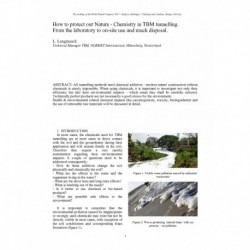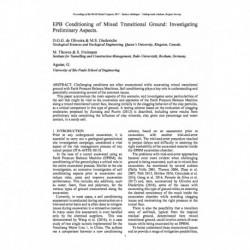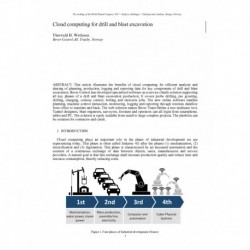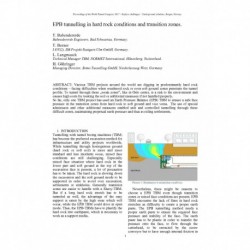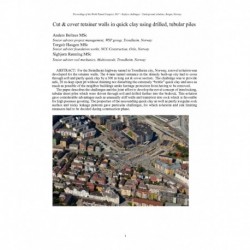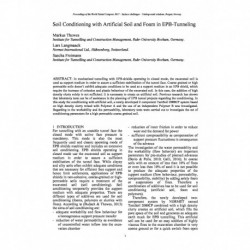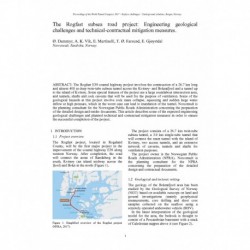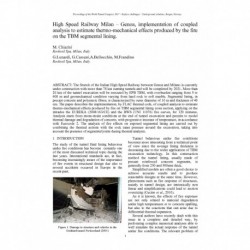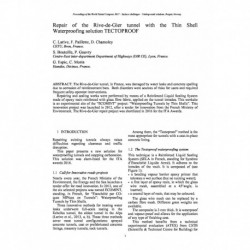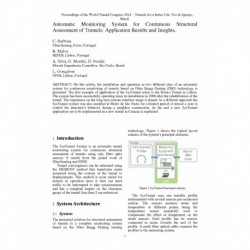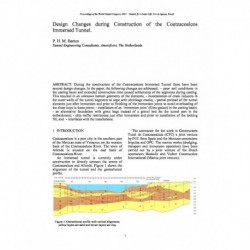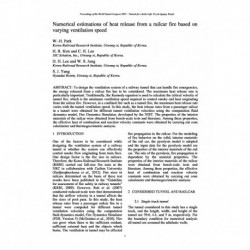No document
Search & filter
Search for a publication
Search & filter
World Tunnelling Congress
WTCThere are 1984 documents.
-
How to protect our Nature - Chemistry in TBM tunnelling. From the laboratory to on-site use and muck disposal
Abstract: All tunnelling methods need chemical additives - modern tunnel construction without chemicals is utterly impossible. When using chemicals, it is important to investigate not only their efficiency but also their environmental impacts – which mean they shall be carefully selected. Technically perfect products are not necessarily a good choice for the environment. Health & environmental...
0,00 € -
EPB Conditioning of Mixed Transitional Ground: Investigating Preliminary Aspects
Abstract: Challenging conditions are often encountered while excavating mixed transitional ground with Earth Pressure Balance Machines. Soil conditioning plays a key role in understanding and potentially overcoming several of the common issues. This paper summarizes the main aspects of this scenario, and investigates some particularities of the soil that might be vital to the excavation and operation of...
0,00 € -
Cloud computing for drill and blast excavation
Abstract: This article illustrates the benefits of cloud computing for efficient analysis and sharing of planning, production, logging and reporting data for key components of drill and blast excavation. Bever Control has developed specialized software as a service (SaaS) solution supporting all key phases of a drill and blast excavation production. It covers probe...
0,00 € -
Large span mined tunnels in soft ground: support design, instrumentation and observational approach
Abstract: The northern 200m of the Liantang Lung Shan highway tunnels in Hong Kong comprises large span mined tunnels excavated through poor ground with low cover. Conventional staged tunnel excavation techniques, with heading (160m) and bench (115m), was adopted. An instrumented observational approach was developed to verify an optimised temporary support system for these challenging ground conditions....
0,00 € -
EPB tunnelling in hard rock conditions and transition zones
Abstract: Various TBM projects around the world are digging in predominantly hard rock conditions – facing difficulties when weathered rock or even soft ground zones penetrate the tunnel profile. To tunnel through these „weak zones”, like in Oslo centre, is a risk to the environment and causes high costs for treating the soil or additional measures if not handled properly. So far, only one TBM project...
0,00 € -
Experience with electronic initiation in civil tunneling without vibration constraints
Abstract: In the last decade electronic initiation in drill & blast tunnels has become an accepted technology for improved control of environmental impacts in urban tunneling. The precise delay timing – when compared to traditional pyrotechnic initiation – and the concept of single hole firing have proven to reliably control vibration emissions when firing large rounds without the need to segment the...
0,00 € -
Cut and cover retainer walls in quick clay using drilled, tubular piles
Abstract: For the Strindheim highway tunnel in Trondheim city, Norway, a novel solution was developed for the retainer walls. The 4-lane tunnel entrance in the densely built-up city had to cross through soft and partly quick clay by a 300 m long cut & cover section. The challenge was to provide safe, 20 m deep open pit without draining nor disturbing the extremely “brittle” quick clay and save as...
0,00 € -
Soil Conditioning with Artificial Soil and Foam in EPB-Tunneling
Abstract: In mechanised tunnelling with EPB-shields operating in closed mode, the excavated soil is used as support medium in order to assure a sufficient stabilisation of the tunnel face. Coarse grained or high permeable soils doesn’t exhibit adequate conditions to be used as a support medium in an EPB shield, which require the increase of cohesion and plastic behaviour of the excavated soil. In this...
0,00 € -
The Rogfast subsea road project: Engineering geological challenges and technical-contractual mitigation measures
Abstract: The Rogfast E39 coastal highway project involves the construction of a 26.7 km long and almost 400 m deep twin-tube subsea tunnel across the Kvitsøy- and Boknafjord and a tunnel up to the island of Kvitsøy. Some special features of the project are a large roundabout intersection area, and tunnels, shafts and rock caverns that will be used for the purpose of ventilation. Some of the geological...
0,00 € -
High-Speed Railway Milan – Genoa, implementation of coupled analysis to estimate thermo-mechanical effects produced...
Abstract: The Stretch of the Italian High Speed Railway between Genoa and Milano is currently under construction with more than 78 km running tunnels and will be completed by 2021. More than 20 km of the tunnel excavation will be executed by EPB TBM, with overburden ranging from 5 to 600 m and geomechanical condition varying from hard rock to soft marble. Segmental lining, in precast concrete and...
0,00 € -
Drill and Blast Vibration Monitoring: Overpass of A10 Motorway
Abstract: Drill and blast excavation produces the propagation of seismic waves with consequent vibration phenomena in the surrounding rock mass, interfering with pre-existing structures or infrastructures. The paper presents the case of Borzoli Erzelli Tunnel (excavation area equal to 120m). The tunnel has to overpass two tubes of existing motorway tunnel “Don Guanella” in operation with only 6m gap. In...
0,00 € -
Repair of the Rive-de-Gier tunnel with the Thin Shell Waterproofing solution TECTOPROOF
Abstract: The Rive-de-Gier tunnel, in France, was damaged by water leaks and concrete spalling due to corrosion of reinforcement bars. Both disorders were sources of risks for users and required frequent safety operator interventions. Repairing and sealing works were performed by means of a Reinforced Liquid Sealing System made of epoxy resin reinforced with glass fibre fabric, applied on...
0,00 € -
Risk Analysis – An improvement to tunnel safety design
Abstract: The Brazilian standard ABNT NBR 15661 requires risk analysis at tunnel designphase. The main goal of risk analysis is to help the designer to identify potentials scenarios ofincidents that can result in fire, explosion, leakages and heavy structural damages endangering driversafety and tunnel life. The risk analysis concept is elaborated in three distinct phases: analysis,evaluation and...
0,00 € -
Automatic Monitoring System for Continuous Structural
Abstract: On this article, the installation and operation in two different sites of an automatic system for continuous monitoring of tunnels based on Fiber Bragg Grating (FBG) technology is presented. The first example of application of the SysTunnel refers to the Rossio Tunnel in Lisbon. The system has been successfully operating since its installation in 2008 after the rehabilitation of the tunnel. The...
0,00 € -
Design Changes during Construction of the Coatzacoalcos Immersed Tunnel
Abstract: During the construction of the Coatzacoalcos Immersed Tunnel there have been several design changes. In the paper, the following changes are addressed: - poor soil conditions in the casting basin and extended construction time caused settlements of the segments during casting. This resulted in an unknown bottom geometry of the elements; - incorporation of crack inducers in the outer walls of...
0,00 € -
Numerical estimations of heat release from a railcar fire based on varying ventilation speed
Abstract: To design the ventilation system of a railway tunnel that can handle fire emergencies, the energy released from a railcar fire has to be considered. The maximum heat release rate is particularly important. Traditionally, the Kennedy equation is used to calculate the critical velocity of tunnel fire, which is the minimum ventilation speed required to control smoke and heat originating from the...
0,00 €

